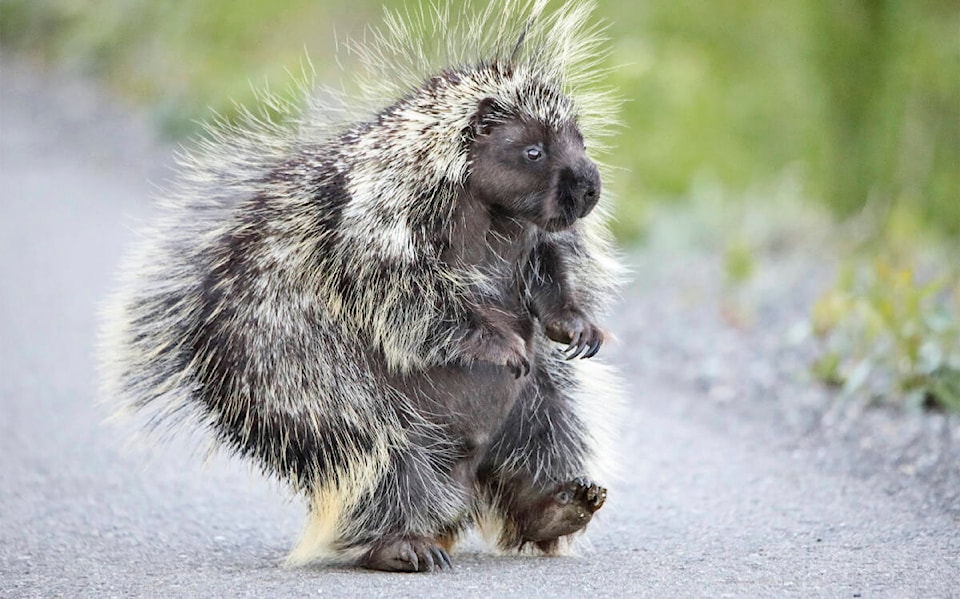Porcupines (Erethizon dorsatum) are a common sight in the Yukon, especially in spring, when they are most often spied lumbering along roadsides with their tell-tale waddling gait. Sometimes called “prickle pigs” or “quill pigs,” the word “porcupine” is derived from the Latin porcus as in “pig” and spina as in “spine” or “quill”— and as anyone who has ever had to handle one know (or had a dog make the tremendous mistake of going after one) those quills mean business.
A porcupine’s thorny defense is more elaborate than simply being a walking pin cushion, says Tom Jung, a senior wildlife biologist with the Yukon government.
“They’re designed not to just stick there [in the would-be predator] — they’re barbed, and they’ll migrate through the body, sometimes pierce vital organs,” he says.
While this incredible adaptation is a highly effective form of self defense — a maw full of quills makes a would-be predator unlikely to tangle with a porcupine twice — it does present an interesting logistical issue. Porcupines are mammals which means that, like all mammals, they reproduce sexually; a male porcupine has to make sweet, sweet porcupine love to a female porcupine in order to make little baby porcupines.
A rational (albeit curious) person, observing these slow-moving, sharp-toothed, ornery rodents — which can weigh as much as 10 kg and are literally covered from tail to nose tip in what amounts to a coat of dislodgeable, razor-sharp, straightened out fish hooks — would be forgiven for asking the following unseemly, but very practical question:
Dude, like…how?
The answer, Jung says, basically amounts to very slowly and very carefully — along with some unique adaptations.
The mating period of porcupines varies depending on their latitude. In the Yukon that’s usually sometime in September or October, says Jung, and courtship is “anything but a rushed affair.” Traditionally quite solitary, the pair must first find each other, and females draw in would-be lovers with a powerful musk, a combination of urine and vaginal secretions which apparently gets the male porcupines all revved up and ready to go-go.
Uldis Roze, author of The North American Porcupine and an expert on the subject, has noted in his work that as males converge, they may fight viciously with each other — even to the death — with the victorious male left to begin the courtship process.
“There’s an awful lot of testing that goes on by the male to see if the female is receptive and accepting,” says Jung. This isn’t simply just good etiquette, but a safety precaution — porcupines can suffer from each other’s quills just as readily as any other animal, not to mention the fact that, in the male’s case, he’s exposing his genitalia, damage to which would not only be unpleasant, but could harm his future reproductive success. As one writer for Slate noted, there’s no such thing as “non-consensual” porcupine sex.
Frankly, it’s at this point that things get a little… odd.
A lovelorn male will climb the tree in which the object of his affections is also perched in, and wait; he may “sing” to her — a low-toned whining — or do what a 1946 paper porcupine reproduction refers to as a “three legged walk” which involves holding his genitals in his left forepaw, or holding a stick between his legs “like a broomstick.”
All this aside, the male has one more, rather exotic tactic in his bag of wooing tricks: he stands upright on his rear legs, and, with his penis fully erect, walks towards the female and sprays her with a stream of urine up to six feet away.
When is a female porcupine ready to mate? When she says so. If the lady porcupine isn’t ready — or just isn’t into her mate — she may try to swipe at him with her tail or scream at him.
When she’s ready, however, and has accepted the overtures of her would-be suitor, the actual business of mating is “quite regular … in terms of the positioning and everything,” says Jung, with one exception; the female raises her tail up and over her back, exposing the underside between them. This part of her tail is quill-free, and kind of acts as a cozy little blanket for the two rodents to get down to business on.
When the deed is done, the two go their separate ways, and if the mating is successful, the pregnant female will give birth in 200 to 210 days — a very long gestation period for a rodent, Jung notes — usually to a single baby porcupine, which is called porcupette.
Despite being ubiquitous in North America, porcupines are a rather understudied species, and there’s a lot about their social and physical lives that remains unknown, Jung says.
One thing is for certain though — you may never think the sex lives of the lumbering, slow, unobstrussive porcupine would be so elaborate.
Lori Fox is a writer and journalist based in Whitehorse. Their first book, This Has Always Been A War, was released on May 3.
